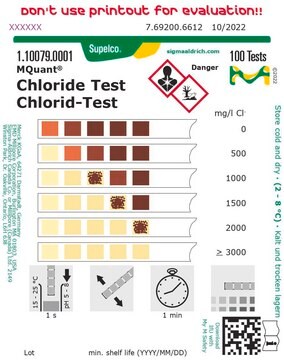60130
Chlorure de potassium
puriss. p.a., ≥99.5% (AT)
About This Item
Produits recommandés
Qualité
puriss. p.a.
Niveau de qualité
Essai
≥99.5% (AT)
Forme
powder or crystals
Impuretés
≤0.001% total nitrogen (N)
pH
5.5-8.0 (20 °C, 50 mg/mL in H2O)
Pf
770 °C (lit.)
Densité
1.98 g/mL at 25 °C (lit.)
Traces d'anions
bromide (Br-): ≤700 mg/kg
iodide (I-): ≤20 mg/kg
phosphate (PO43-): ≤5 mg/kg
sulfate (SO42-): ≤30 mg/kg
Traces de cations
Ca: ≤50 mg/kg
Cd: ≤5 mg/kg
Co: ≤5 mg/kg
Cr: ≤5 mg/kg
Cu: ≤5 mg/kg
Fe: ≤2 mg/kg
Mg: ≤10 mg/kg
Mn: ≤5 mg/kg
Na: ≤200 mg/kg
Ni: ≤5 mg/kg
Pb: ≤5 mg/kg
Zn: ≤5 mg/kg
Chaîne SMILES
[Cl-].[K+]
InChI
1S/ClH.K/h1H;/q;+1/p-1
Clé InChI
WCUXLLCKKVVCTQ-UHFFFAOYSA-M
Vous recherchez des produits similaires ? Visite Guide de comparaison des produits
Description générale
Application
Code de la classe de stockage
13 - Non Combustible Solids
Classe de danger pour l'eau (WGK)
WGK 1
Point d'éclair (°F)
Not applicable
Point d'éclair (°C)
Not applicable
Faites votre choix parmi les versions les plus récentes :
Déjà en possession de ce produit ?
Retrouvez la documentation relative aux produits que vous avez récemment achetés dans la Bibliothèque de documents.
Les clients ont également consulté
Notre équipe de scientifiques dispose d'une expérience dans tous les secteurs de la recherche, notamment en sciences de la vie, science des matériaux, synthèse chimique, chromatographie, analyse et dans de nombreux autres domaines..
Contacter notre Service technique


